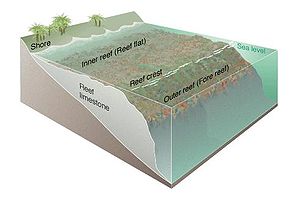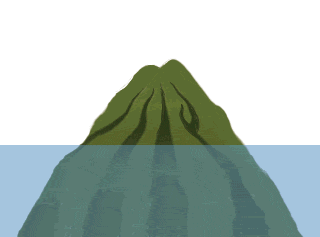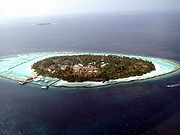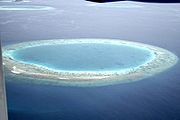
Fringing reef
Encyclopedia

Coral reef
Coral reefs are underwater structures made from calcium carbonate secreted by corals. Coral reefs are colonies of tiny living animals found in marine waters that contain few nutrients. Most coral reefs are built from stony corals, which in turn consist of polyps that cluster in groups. The polyps...
s recognized by most coral reef scientists. It is distinguished from the other two main types (barrier reef
Barrier reef
Barrier reef may refer to:*a kind of coral reef*the Great Barrier Reef in Australia*the Mesoamerican Barrier Reef System*the Belize Barrier Reef*the New Caledonia Barrier Reef*Barrier Reef , an Australian television series...
s and atoll
Atoll
An atoll is a coral island that encircles a lagoon partially or completely.- Usage :The word atoll comes from the Dhivehi word atholhu OED...
s) in that it has either an entirely shallow backreef zone (lagoon) or none at all. If a fringing reef grows directly from the shoreline (see photo, right) the reef flat extends right to the beach and there is no backreef. In other cases (e.g., most of The Bahamas
The Bahamas
The Bahamas , officially the Commonwealth of the Bahamas, is a nation consisting of 29 islands, 661 cays, and 2,387 islets . It is located in the Atlantic Ocean north of Cuba and Hispaniola , northwest of the Turks and Caicos Islands, and southeast of the United States...
), fringing reefs may grow hundreds of yards from shore and contain extensive backreef areas with numerous seagrass meadows and patch reefs.
This type of coral reef is the most common type of reef found in the Caribbean
Caribbean Sea
The Caribbean Sea is a sea of the Atlantic Ocean located in the tropics of the Western hemisphere. It is bounded by Mexico and Central America to the west and southwest, to the north by the Greater Antilles, and to the east by the Lesser Antilles....
and Red Sea
Red Sea
The Red Sea is a seawater inlet of the Indian Ocean, lying between Africa and Asia. The connection to the ocean is in the south through the Bab el Mandeb strait and the Gulf of Aden. In the north, there is the Sinai Peninsula, the Gulf of Aqaba, and the Gulf of Suez...
. It is Darwin
Charles Darwin
Charles Robert Darwin FRS was an English naturalist. He established that all species of life have descended over time from common ancestry, and proposed the scientific theory that this branching pattern of evolution resulted from a process that he called natural selection.He published his theory...
’s belief that fringing reefs are the first kind of reefs to form around a landmass in a long-term reef growth process.
Barrier reef
Sometimes it is hard to tell the difference between fringing reefs and another type of reef called a barrier reef. One of the ways that these two types of reefs are separated is based on the depth of the lagoon in the back reef which is the area near to shore. Barrier reefs have at least some deep portions; fringing reefs do not. Another major difference is that barrier reefs tend to be much farther away from shore than fringing reefs.Structure

Reef flat
The reef flat is the shoreward, flat, broadest area of the reef. The reef flat is found in fairly shallow water, and can be uncovered during low tide. This area of the reef is only slightly sloped towards the open ocean.Since the reef flat is adjacent or nearly adjacent to land, it sustains the most damage from runoff and sediments. Typically, few of the flat's corals are alive. Seagrasses, seaweeds, and soft corals are often found there.
Reef slope (fore reef)
The reef slope is found at the outer edge of the fringing reef, closest to the open ocean. This area of the reef is often quite steep and descends either to a relatively shallow sand bottom or to depths too great to allow coral growth.Coral grows much more abundantly on this slope, both in numbers and in species diversity. This is mostly because runoff and sediments are less concentrated here. Greater wave action disperses pollutants and carries nutrients to this area.
The upper portion of this slope is called the reef crest. The crest has the best balance between sunlight and waves, so coral grows fastest here. The base of the slope receives the least sunlight and has the least growth out of the whole slope.
Location of fringing reefs
Fringing reefs are located near shore in the tropics in many areas and are the most common reef type. Coral reefs are found in the tropics in which the water is between 18°C and 30°C.Many of the Great Barrier Reef
Great Barrier Reef
The Great Barrier Reef is the world'slargest reef system composed of over 2,900 individual reefs and 900 islands stretching for over 2,600 kilometres over an area of approximately...
's components are actually fringing reefs. Of the close to 3400 individual reefs, 760 are actually fringing reefs.
Reefs growth



Catch-up: These reefs initially grow more slowly than sea level rises, but eventually catch up when the rise in sea level slows or stops.
Give-up: These reefs are not able to grow fast enough and are "drowned out".
Reef development
The most important determinant of reef growth is available space as determined by sea level changes. Sea level changes are mostly due to glaciation or plate tectonics. There are six different major ways in which fringing reefs grow and develop.- Reefs can develop vertically as far as the space below the surface allows. The reef generally grows upward from a starting point towards the surface. Once the reef crest reaches sea level the reef may begin growing seaward. Growth begins after flooding, mostly from parts of the reef that have died. Because the reef grows upward, the oldest sediments are found lower in the reef. The reef flat's age indicates when the reef reached sea level. Catch-up reefs have younger surfaces than keep-up reefs of this type.
- Reefs can expand seaward from the shore. This requires a fairly constant sea level. If the sea level drops, the reef flat in more seaward areas slopes downward.
- Reefs can grow atop muddy sediments which can predate the reef or accrete along with the reef's growth. These reefs also grow seaward from the shore. Older sediments are closest to shore and are not buried. Coral, seagrass and algae filter sediment before it is placed on the reef crest.
- Reefs can form in a gradual, sporadic manner, with alternate vertical and horizontal growth episodes. In this type of fringing reef formation there are multiple separate reefs that are found parallel to the shore and the original fringing reef. These reefs become a single, large reef when reef sediments fill in the spaces between the different reefs.
- Reefs can develop when an offshore reef grows to sea level forming a barrier. When the crest grows faster than the flat, a lagoon forms. The lagoon then fills with inshore sediments.
- Offshore reefs can form their barrier using storms to move coral and other debris inwards. The recurring storms continually reshape the seaward side of such reefs.
Effect of tectonic activity
Tectonic activity can have very detrimental effects. An earthquake on Ranongga Island in the Solomon IslandsSolomon Islands
Solomon Islands is a sovereign state in Oceania, east of Papua New Guinea, consisting of nearly one thousand islands. It covers a land mass of . The capital, Honiara, is located on the island of Guadalcanal...
moved 80% of its fringing reef permanently above sea level. Northern reefs became elevated 1m above the high tide water height, whereas on the south side reefs moved 2 to 3m above the water height.
Species diversity
The backreef area has the least species diversity, which increases seaward towards the reef crest. Some of this difference is due to eutrophication from increased nutrients, sediments and toxicity due to domestic and industrial wastes.More macrophytes live on the bottom due to the increases in nutrients. They also feel that this increase in nutrients has caused an increase in the number of phytoplankton that are present above the coral reef. The increase in phytoplankton has led to reduced light reaching the coral species and has also led to a greater number of larger invertebrates to be found.
The sediments that are present within the environment cause increased turbidity and may smother some organisms. The corals present on the fringing reefs use four processes to get rid of sediments which include polyp distension, tentacular movement, ciliary action and mucus production. The corals that are present then are thus likely those that can get rid of the sediments the best.
Brooding corals have higher growth and reproduction rates than others.
In the area of the reef closest to the shore there is generally a lot of fleshy algae which forms on sand and coral rubble. These types of algae include Lyngbia sp. and Oscilatoria sp.
Over recent years the dominant species in the reef flat have been affected by environmental changes. On fringing reefs in Barbados, species such as Diploria strigosa, Palythoa mamillosa, and Diadema antillarum are found.
The reef crest's most common species is Porites porites, although there are also significant areas covered in fleshy algae too.

